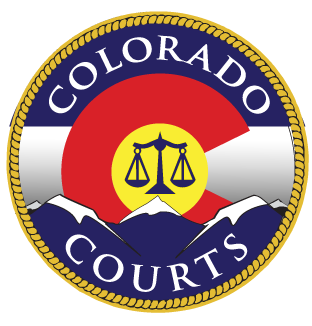About Garnishment of Personal Property
Garnishment of personal property is used to collect on a judgment by garnishing a person's bank accounts or other assets.
"Interrogatories" are a series of approved questions to find what assets a debtor has. "Garnishment" is a legal process to collect money from a debtor's assets.
Minimum wage: Federal minimum wage is $7.25 as of July 1, 2009. Colorado minimum wage is $14.81 as of January 1, 2025.
Criteria for Garnishment of Personal Property
If you went to court and got a money judgment against someone, but they are not paying you the money, you can go after that person's personal property, including bank accounts or other assets (other than wages) by filing garnishment paperwork with the court.
The money owed to you can then be paid from these assets, or property can be sold in order to pay you what you are owed.
How to Start
How to Start
You will file your paperwork with the same court where the case awarding you a money judgment is located. You will also use the same case number.
First, you need to determine where the person who owes you money banks or owns property. If you already have this information, you can skip this step.
Note: Some courts have local policies that may be slightly different than the instructions below. Make sure to check with your local court as to their local policy.
County Court Process
If you do not know where the person who owes you money banks or owns property, and the case where you were awarded money is in county court, follow these steps:
- Use the forms link above to download and complete JDF 105 Pattern Interrogatories Under C.R.C.P. 369(g) - Individual.
- This form asks questions that the person who owes you money is required to answer (such as where they bank and what type of property they own).
- Fill out the information in the box at the top of the form (called the "case caption").
- On the first line below the case caption, enter the name of the person who owes you money.
- The person who owes you money will need to fill out the rest of the form by answering the questions.
- Send the form to the person who owes you money. There are two different ways you can send them this form:
- You can file the form with the court, and the court will send the form to the person who owes you money; or
- You can arrange to deliver the form to the person who owes you money and file proof of service with the court. The process of arranging to have the form delivered is known as personal service. Self-Help Service of Process will help you understand how to arrange for personal service and how to return proof of service to the court.
- Wait for the person who owes you money to send back his/her answers. He/she must file the answers with the court and send you a copy no later than 14 days after he/she receives the form. Once you get the answers back, you will have the information you need to file the paperwork for garnishment.
Small Claims Court Process
If you do not know where the person who owes you money banks or owns property, and the case where you were awarded money is in small claims court, follow these steps:
- Use the forms link above to download and complete JDF 252A Motion and Order for Interrogatories - Short Form or JDF 252B Motion and Order for Interrogatories - Long Form, then file the form with the court.
- These forms ask questions that the person who owes you money is required to answer (such as where they bank and what type of property they own).
- Fill out the information in the box at the top of the form (called the "case caption").
- Fill out the information below where it says "Motion" and sign where it says "Judgment Creditor's Signature".
- The court will fill out the "Order" part of the form, and the person who owes you money will need to answer the questions.
- The court will send the form to the person who owes you money, and they will have 14 days to send back their answers. Once the answers are received, you will have the information you need to file the paperwork for garnishment.
District Court Process
If the case where you were awarded money is in district court, see Rule 69(d) of the Colorado Rules of Civil Procedure for information on how to send questions to the person who owes you money, which they are required to answer.
Forms and Paperwork Required
Forms and Paperwork Required
Use the forms link above to download and complete the Garnishment of Personal Property forms. For detailed instructions on how to fill out these forms, review JDF 82 How to Collect on a Judgment.
Paperwork Tips
You and the person who owes you money will have the same "identities" to the court as you did in the original case where the court awarded you the money. For example, if you were the Plaintiff or Petitioner in the original case, you will be the Plaintiff or Petitioner when you file this paperwork.
You will use the same case number from your original case.
If you are owed money, you are referred to as the Judgment Creditor. The person who owes you money is referred to as the Judgment Debtor. The bank or other person who has possession or control of the assets or other personal property of the person who owes you money is known as the Garnishee.
Fill out lines 1 - 5 at the top of Form 29 Writ of Garnishment with Notice of Exemption and Pending Levy and sign below line 5. You must sign this form in front of a notary public or court clerk. You can find a notary public by looking in the Yellow Pages, on the Internet, or by going to your local bank.
How to Submit Paperwork to the Court
- Take your completed Form 29 Writ of Garnishment with Notice of Exemption and Pending Levy to the clerk at the counter in the courthouse. Give the form to the clerk to file your case.
- After you file Form 29 Writ of Garnishment with Notice of Exemption and Pending Levy, the clerk at the court will sign and issue the Writ back to you after you pay a filing fee. If you do not think you can afford the filing fee, fill out form JDF 205 Motion to File Without Payment and Supporting Financial Affidavit and JDF 206 Finding and Order Concerning Payment of Fees to request a waiver of the filing fee, or visit our File Without Payment section for complete information.
Garnishment of Personal Property Filing Fees | |
|---|---|
| Writ of Garnishment | $45.00 |
Arrange to Serve the Paperwork on the Garnishee
After you file Form 29 Writ of Garnishment with Notice of Exemption and Pending Levy, and the court signs and issues the Writ back to you, you must arrange to deliver a copy of Form 29 Writ of Garnishment with Notice of Exemption and Pending Levy to the bank or person who has possession or control of the assets or property of the person who owes you money (the Garnishee).
You must also arrange to deliver a copy of Form 29 Writ of Garnishment with Notice of Exemption and Pending Levy, along with a copy of Form 30 Claim of Exemption to Writ of Garnishment with Notice, to the person who owes you money (the Judgment Debtor).
The process of having these forms delivered is known as personal service. Self-Help Service of Process will help you understand how to arrange for personal service and how to return proof of service to the court.
What Happens Next?
After you serve Form 29 Writ of Garnishment with Notice of Exemption and Pending Levy on the bank or person who has possession or control of the personal property or assets of the person who owes you money (the Garnishee), they will fill out the answer part of the form, file it with the court, and send you a copy.
After you serve Form 29 Writ of Garnishment with Notice of Exemption and Pending Levy and Form 30 Claim of Exemption to Writ of Garnishment with Notice on the person who owes you money (the Judgment Debtor), they will have 14 days to fill out Form 30 Claim of Exemption to Writ of Garnishment with Notice and send it to you to say that their property or assets should not be taken.
If the person who owes you money does not send you a copy of Form 30 Claim of Exemption to Writ of Garnishment with Notice within 14 days, fill out Form 89 Notice to Garnishee, Application of Funds to Judgment, and Release of Funds to Judgment Creditor and file it with the court. The court can then order money to be paid to you or the property to be sold to cover the money that you are owed.
If the person who owes you money sends you a copy of Form 30 Claim of Exemption to Writ of Garnishment with Notice, the court will need to set a hearing to resolve the issues.
Satisfaction of Judgment
Once the person who owes you money pays you everything in full, fill out and file JDF 111 Satisfaction of Judgment with the court. This will let the court know that you have been paid everything you are owed and that the case is over. You must sign this form in front of a notary public or court clerk. You can find a notary public by looking in the Yellow Pages, on the Internet, or by going to your local bank.
 Colorado Judicial Branch
Colorado Judicial Branch
